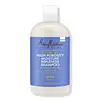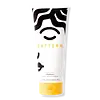What's inside
What's inside
 Key Ingredients
Key Ingredients

No key ingredients
 Benefits
Benefits

 Concerns
Concerns

 Ingredients Side-by-side
Ingredients Side-by-side

Water
Skin ConditioningCocamidopropyl Betaine
CleansingGlycerin
HumectantGlycol Distearate
EmollientSodium Lauroyl Isethionate
CleansingSodium Chloride
MaskingButyrospermum Parkii Butter
Skin ConditioningSchinziophyton Rautanenii Kernel Oil
EmollientSimmondsia Chinensis Seed Oil
EmollientAloe Barbadensis Leaf Juice
Skin ConditioningAdansonia Digitata Seed Oil
EmollientPanthenol
Skin ConditioningCoconut Acid
CleansingPolyquaternium-10
Guar Hydroxypropyltrimonium Chloride
Skin ConditioningStearamidopropyl Dimethylamine
EmulsifyingPEG-150 Distearate
EmulsifyingSodium Methyl Cocoyl Taurate
CleansingCitric Acid
BufferingLaureth-4
EmulsifyingCaprylic Acid
CleansingCapric Acid
CleansingLauric Acid
CleansingSodium Isethionate
CleansingSodium Methyltaurate
Skin ConditioningSodium Acetate
BufferingSodium Phytate
Sodium Benzoate
MaskingCaprylyl Glycol
EmollientParfum
MaskingWater, Cocamidopropyl Betaine, Glycerin, Glycol Distearate, Sodium Lauroyl Isethionate, Sodium Chloride, Butyrospermum Parkii Butter, Schinziophyton Rautanenii Kernel Oil, Simmondsia Chinensis Seed Oil, Aloe Barbadensis Leaf Juice, Adansonia Digitata Seed Oil, Panthenol, Coconut Acid, Polyquaternium-10, Guar Hydroxypropyltrimonium Chloride, Stearamidopropyl Dimethylamine, PEG-150 Distearate, Sodium Methyl Cocoyl Taurate, Citric Acid, Laureth-4, Caprylic Acid, Capric Acid, Lauric Acid, Sodium Isethionate, Sodium Methyltaurate, Sodium Acetate, Sodium Phytate, Sodium Benzoate, Caprylyl Glycol, Parfum
Water
Skin ConditioningSodium C14-16 Olefin Sulfonate
CleansingCocamidopropyl Betaine
CleansingPropanediol
SolventGlycol Distearate
EmollientArgania Spinosa Kernel Oil
EmollientCocos Nucifera Oil
MaskingMel
EmollientMelaleuca Alternifolia Leaf Oil
AntioxidantOlea Europaea Fruit Oil
MaskingBiotin
AntiseborrhoeicPersea Gratissima Oil
Skin ConditioningRicinus Communis Seed Oil
MaskingSimmondsia Chinensis Seed Oil
EmollientButyrospermum Parkii Butter
Skin ConditioningAloe Barbadensis Leaf Juice
Skin ConditioningPrunus Amygdalus Dulcis Oil
Skin ConditioningGlycine Soja Oil
EmollientGlycine Soja Sterols
EmollientGlycolipids
Skin ConditioningGlycerin
HumectantPhospholipids
Skin ConditioningAmodimethicone
Guar Hydroxypropyltrimonium Chloride
Skin ConditioningHydroxyethylcellulose
Emulsion StabilisingLauryl Lactyl Lactate
Skin ConditioningHydroxyacetophenone
AntioxidantPEG-150 Distearate
EmulsifyingParfum
MaskingHydrolyzed Vegetable Protein Pg-Propyl Silanetriol
Skin ConditioningCellulose
AbsorbentPhenoxyethanol
PreservativeCitric Acid
BufferingPEG-150 Stearate
Disodium EDTA
PEG-1m
Emulsion StabilisingStearic Acid
CleansingSodium Hydroxide
BufferingSodium Acetate
BufferingPotassium Sorbate
PreservativeSodium Benzoate
MaskingLinalool
PerfumingWater, Sodium C14-16 Olefin Sulfonate, Cocamidopropyl Betaine, Propanediol, Glycol Distearate, Argania Spinosa Kernel Oil, Cocos Nucifera Oil, Mel, Melaleuca Alternifolia Leaf Oil, Olea Europaea Fruit Oil, Biotin, Persea Gratissima Oil, Ricinus Communis Seed Oil, Simmondsia Chinensis Seed Oil, Butyrospermum Parkii Butter, Aloe Barbadensis Leaf Juice, Prunus Amygdalus Dulcis Oil, Glycine Soja Oil, Glycine Soja Sterols, Glycolipids, Glycerin, Phospholipids, Amodimethicone, Guar Hydroxypropyltrimonium Chloride, Hydroxyethylcellulose, Lauryl Lactyl Lactate, Hydroxyacetophenone, PEG-150 Distearate, Parfum, Hydrolyzed Vegetable Protein Pg-Propyl Silanetriol, Cellulose, Phenoxyethanol, Citric Acid, PEG-150 Stearate, Disodium EDTA, PEG-1m, Stearic Acid, Sodium Hydroxide, Sodium Acetate, Potassium Sorbate, Sodium Benzoate, Linalool
Ingredients Explained
These ingredients are found in both products.
Ingredients higher up in an ingredient list are typically present in a larger amount.
Aloe Barbadensis Leaf Juice comes from leaves of the aloe plant. Aloe Barbadensis Leaf Juice is best known for helping to soothe sunburns. It is also anti-inflammatory, moisturizing, antiseptic, and can help heal wounds.
Aloe is packed with good stuff including Vitamins A, C, and E. These vitamins are antioxidants, which help fight free-radicals and the damage they may cause. Free-radicals are molecules that may damage your skin cells, such as pollution.
Aloe Barbadensis Leaf Juice also contains sugars. These sugars come in the form of monosaccharides and polysaccharides, folic acid, and choline. These sugars are able to help bind moisture to skin.
It also contains minerals such as calcium, 12 anthraquinones, fatty acids, amino acids, and Vitamin B12.
Learn more about Aloe Barbadensis Leaf JuiceThis ingredient is also known as shea butter. It is an effective skin hydrator and emollient.
Emollients help soothe and soften your skin. It does this by creating a protective film on your skin. This barrier helps trap moisture and keeps your skin hydrated. Emollients may be effective at treating dry or itchy skin.
Shea butter is rich in antioxidants. Antioxidants help fight free-radicals, or molecules that may harm the body. It is also full of fatty acids including stearic acid and linoleic acid. These acids help replenish the skin and keep skin moisturized.
While Shea Butter has an SPF rating of about 3-4, it is not a sunscreen replacement.
Shea butter may not be fungal acne safe. We recommend speaking with a professional if you have any concerns.
Learn more about Butyrospermum Parkii ButterCitric Acid is an alpha hydroxy acid (AHA) naturally found in citrus fruits like oranges, lemons, and limes.
Like other AHAs, citric acid can exfoliate skin by breaking down the bonds that hold dead skin cells together. This helps reveal smoother and brighter skin underneath.
However, this exfoliating effect only happens at high concentrations (20%) which can be hard to find in cosmetic products.
Due to this, citric acid is usually included in small amounts as a pH adjuster. This helps keep products slightly more acidic and compatible with skin's natural pH.
In skincare formulas, citric acid can:
While it can provide some skin benefits, research shows lactic acid and glycolic acid are generally more effective and less irritating exfoliants.
Most citric acid used in skincare today is made by fermenting sugars (usually from molasses). This synthetic version is identical to the natural citrus form but easier to stabilize and use in formulations.
Read more about some other popular AHA's here:
Learn more about Citric AcidCocamidopropyl Betaine is a fatty acid created by mixing similar compounds in coconut oil and dimethylaminopropylamine, a compound with two amino groups.
This ingredient is a surfactant and cleanser. It helps gather the dirt, pollutants, and other impurities in your skin to be washed away. It also helps thicken a product and make the texture more creamy.
Being created from coconut oil means Cocamidopropyl Betaine is hydrating for the skin.
While Cocamidopropyl Betaine was believed to be an allergen, a study from 2012 disproved this. It found two compounds in unpure Cocamidopropyl Betaine to be the irritants: aminoamide and 3-dimethylaminopropylamine. High-grade and pure Cocamidopropyl Betaine did not induce allergic reactions during this study.
Learn more about Cocamidopropyl BetaineGlycerin is already naturally found in your skin. It helps moisturize and protect your skin.
A study from 2016 found glycerin to be more effective as a humectant than AHAs and hyaluronic acid.
As a humectant, it helps the skin stay hydrated by pulling moisture to your skin. The low molecular weight of glycerin allows it to pull moisture into the deeper layers of your skin.
Hydrated skin improves your skin barrier; Your skin barrier helps protect against irritants and bacteria.
Glycerin has also been found to have antimicrobial and antiviral properties. Due to these properties, glycerin is often used in wound and burn treatments.
In cosmetics, glycerin is usually derived from plants such as soybean or palm. However, it can also be sourced from animals, such as tallow or animal fat.
This ingredient is organic, colorless, odorless, and non-toxic.
Glycerin is the name for this ingredient in American English. British English uses Glycerol/Glycerine.
Learn more about GlycerinGlycol Distearate serves as a pearlizing or opacifying agent in cosmetic products.
It's often included in cleansers and haircare products to give them a lustrous or shimmering appearance.
It is derived from stearic acid, a natural fatty acid commonly found in vegetable oils and animal fats.
Glycol Distearate isn't fungal acne safe.
Learn more about Glycol DistearateThis ingredient is derived from guar gum.
It is a conditioning ingredient, meaning it helps soften skin and hair.
Parfum is a catch-all term for an ingredient or more that is used to give a scent to products.
Also called "fragrance", this ingredient can be a blend of hundreds of chemicals or plant oils. This means every product with "fragrance" or "parfum" in the ingredients list is a different mixture.
For instance, Habanolide is a proprietary trade name for a specific aroma chemical. When used as a fragrance ingredient in cosmetics, most aroma chemicals fall under the broad labeling category of “FRAGRANCE” or “PARFUM” according to EU and US regulations.
The term 'parfum' or 'fragrance' is not regulated in many countries. In many cases, it is up to the brand to define this term.
For instance, many brands choose to label themselves as "fragrance-free" because they are not using synthetic fragrances. However, their products may still contain ingredients such as essential oils that are considered a fragrance by INCI standards.
One example is Calendula flower extract. Calendula is an essential oil that still imparts a scent or 'fragrance'.
Depending on the blend, the ingredients in the mixture can cause allergies and sensitivities on the skin. Some ingredients that are known EU allergens include linalool and citronellol.
Parfum can also be used to mask or cover an unpleasant scent.
The bottom line is: not all fragrances/parfum/ingredients are created equally. If you are worried about fragrances, we recommend taking a closer look at an ingredient. And of course, we always recommend speaking with a professional.
Learn more about ParfumPeg-150 Distearate is an emulsifier and thickening agent. It is created from stearic acid.
As an emulsifier, peg-150 distearate helps other ingredients dissolve. This helps prevent ingredient separation.
This ingredient may not be Malassezia folliculitis, or fungal-acne safe.
Learn more about PEG-150 DistearateThis oil comes from the seeds of the desert shrub called Jojoba. It is more commonly known as jojoba oil, a non-comedogenic oil.
Jojoba oil does not contain fragrance and has many fatty-acids, making it a great soothing ingredient.
It also contains Vitamin E, a great moisturizing ingredient. Vitamin E is also an antioxidant and protects your skin against oxidative damage.
This ingredient humectant properties, meaning it helps draw moisture from the air. This helps keep your skin hydrated.
While jojoba has antibacterial properties, it is only able to kill some strains of bacteria.
Studies also show it helps in wound healing. In fact, Indigenous cultures have used jojoba as a moisturizer and to help treat burns for centuries.
Fun fact: Jojoba oil similar to natural human skin sebum, so it has a great effect on dry skin. It is also promising with helping to regulate sebum production.
Due to its fatty acid content, Jojoba oil may not be fungal acne safe. We recommend speaking with a professional if you have any concerns.
Learn more about Simmondsia Chinensis Seed OilWe don't have a description for Sodium Acetate yet.
Sodium Benzoate is a preservative. It's used in both cosmetic and food products to inhibit the growth of mold and bacteria. It is typically produced synthetically.
Both the US FDA and EU Health Committee have approved the use of sodium benzoate. In the US, levels of 0.1% (of the total product) are allowed.
Sodium benzoate works as a preservative by inhibiting the growth of bacteria inside of cells. It prevents the cell from fermenting a type of sugar using an enzyme called phosphofructokinase.
It is the salt of benzoic acid. Foods containing sodium benzoate include soda, salad dressings, condiments, fruit juices, wines, and snack foods.
Studies for using ascorbic acid and sodium benzoate in cosmetics are lacking, especially in skincare routines with multiple steps.
We always recommend speaking with a professional, such as a dermatologist, if you have any concerns.
Learn more about Sodium BenzoateWater. It's the most common cosmetic ingredient of all. You'll usually see it at the top of ingredient lists, meaning that it makes up the largest part of the product.
So why is it so popular? Water most often acts as a solvent - this means that it helps dissolve other ingredients into the formulation.
You'll also recognize water as that liquid we all need to stay alive. If you see this, drink a glass of water. Stay hydrated!
Learn more about Water